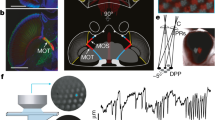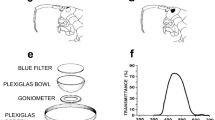Summary
Optical characteristics of the dioptric system in the ommatidia of Musca have been analysed by use of “antidromic illumination” of the eye. The results indicate that the distal endings of the rhabdomers terminate near the focal plane of the dioptrics and that the quality of the lens is high enough to resolve some details of their shape. — Using optical methods it has been possible to confirm directly that the optical axes of 7 individual rhabdomers from 7 different ommatidia all converge to a common point in the distant surroundings. This is a characteristic for compound eyes of the “neural superposition” type. — The results are discussed on the basis of the hypothesis that the Musca eye is composed of two functionally different subsystems: One system (D) with high absolute sensitivity and low spatial resolution consisting of the sense cells no. 1 to 6, and a second system (H) with high spatial resolution and low absolute sensitivity composed of cells no. 7 and 8.
Similar content being viewed by others
Literatur
Barlow, H. B.: The size of ommatidia in apposition eyes. J. exp. Biol. 29, 667–674 (1952); - Visual resolution and the diffraction limit. Science 149, 553–556 (1965).
Braitenberg, V.: Patterns of projection in the visual system of the fly. I. Retina-Lamina projections. Exp. Brain Res. 3, 271–298 (1967).
Fermi, G., u. W. Reichardt: Optomotorische Reaktionen der Fliege Musca domestica. Abhängigkeit der Reaktion von der Wellenlänge, der Geschwindigkeit, dem Kontrast und der mittleren Leuchtdichte bewegter periodischer Muster. Kybernetik 2, 15–28 (1963).
Götz, K. G.: Optomotorische Untersuchungen des visuellen Systems einiger Augenmutanten der Fruchtfliege Drosophila. Kybernetik 2, 77–92 (1964); - Die optischen Übertragungseigenschaften der Komplexaugen von Drosophila. Kybernetik 2, 215–221 (1965).
Kirschfeld, K.: Die Projektion der optischen Umwelt auf das Raster der Rhabdomere im Komplexauge von Musca. Exp. Brain Res. 3, 248–270 (1967).
Kuiper, J. W.: On the image formation in a single ommatidium of the compound eye of diptera. The functional organization of the compound eye. Proceedings of the Internat. Symposium held in Stockholm, October 1965, Wenner-Gren Center. Internat. Symposium Series 7. Oxford: Pergamon Press.
Langer, H.: Nachweis dichroitischer Absorption des Sehfarbstoffes in den Rhabdomeren des Insektenauges. Z. vergl. Physiol. 51, 258–263 (1965a); - Spektrometrische Untersuchungen der Absorptionseigenschaften einzelner Rhabdomere im Facettenauge. Verh. dtsch. zool. Ges. 329–338 (1965b).
Langer, H., and B. Thorell: Microspectrophotometry of single rhabdomeres in the insect eye. Exp. Cell Res. 41, 673–677 (1966).
Mallock, A.: Divided composite eyes. Nature (Lond.) 110, 770–771 (1922).
McCann, G. D., and G. F. MacGinitie: Optomotor response studies of insect vision. Proc. roy. Soc. Edinb. B 163, 369–401 (1965).
Palka, J.: Diffraction and visual acuity of insects. Science 149, 551–553 (1965).
Reichardt, W.: Über das optische Auflösungsvermögen der Facettenaugen von Limulus. Kybernetik 1, 57–69 (1961).
Schneider, G.: Zur Spektralempfindlichkeit des Komplexauges von Calliphora. Z. vergl. Physiol. 39, 1–20 (1956).
Trujillo-Cenóz, O., and J. Melamed: Electron microscope observations on the peripheral and intermediate retinas of dipterans. The functional organization of the compound eye. Proceedings of the Internat. Symposium held in Stockholm, October 1965, Wenner-Gren Center. Internat. Symposium Series 7. Oxford: Pergamon Press; - Compound eye of dipterans: Anatomical basis for integration. An electron microscope study. J. Ultrastruct. Res. 16, 395–398 (1966).
Vries, H. de: Physical aspects of sense organs. Progr. Biophys. 6, 208–264 (1956).
Author information
Authors and Affiliations
Additional information
Wir danken Herrn Dr. K. G. Götz, Herrn Prof. W. Reichardt und Herrn Dr. D. Varjú für wertvolle Diskussionen, Fräulein T. Wiegand für Mithilfe bei den Experimenten, sowie Herrn E. Freiberg für das Fertigstellen der Abbildungen.
Rights and permissions
About this article
Cite this article
Kirschfeld, K., Franceschini, N. Optische Eigenschaften der Ommatidien im Komplexauge von Musca . Kybernetik 5, 47–52 (1968). https://doi.org/10.1007/BF00272694
Received:
Issue Date:
DOI: https://doi.org/10.1007/BF00272694




